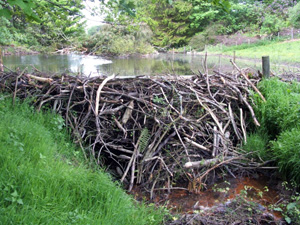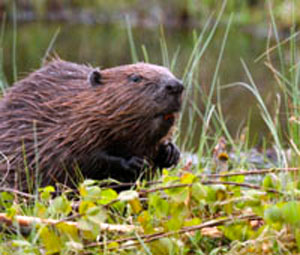Reforesting the Uplands / Drying out the Lowlands

Having been flooded out of my house ten years ago, due to a flash flood, I know that the pain and sadness of flooding is immense. My heart goes out to those who are battling the rising water levels caused by some of the most extreme weather for a century. It’s not surprising that in their anger, people are lashing out at the nearest targets.
Not enough dredging ? Dredging isn’t the answer. Increasing the capacity of the river channel by a small amount is not going to contain the huge extra volume of water spreading across the floodplain. And it will probably just dump the water on someone else downstream.
The answer lies, as people are starting to slowly realise, with increasing the roughness of the upper catchments. British and European policy for decades has been to smooth out the uplands to make it easier and more productive for agriculture. Land has been drained, streams straightened and channelled, rivers canalised, woodlands felled, hedges pulled out and a smooth monotonous landscape created, appreciated only by sheep, shepherds and the Tourist Boards. Farmers are now paid their Single Farm Payment, by far the largest of the subsidies, so long as the land is free from ‘unwanted vegetation’. So they spend a lot of their time, not farming but making the hillsides even smoother.  Even less capable of holding back water and allowing it to percolate back down into the soil, to be released slowly, filling up the aquifers and reducing the peak flows.
Even less capable of holding back water and allowing it to percolate back down into the soil, to be released slowly, filling up the aquifers and reducing the peak flows.
What is needed is more ponds, wetland, woodlands, meanders, ox-bow lakes and scrub vegetation in the uplands. And beavers ! Beavers are wonderful hydrologists and will build dams, creating ponds and wetlands and forcing the water to flow more slowly. This can improve fish stocks and hugely increase biodiversity. There are over 200 beavers now living wild in the Tay system as well as an official trial in Argyll.
So, let’s get busy reforesting and rewilding the uplands, thereby protecting the poor people in the lowlands.
Donald McPhillimy
Comments are closed for this post.
Discussion
The problem is the ownership of upland areas. Until the ownership passes to more benign environmentally sensitive individuals then we have impasse. I look forward to the day in my great-grandchildren’s time when all of upland Britain is reforested and all native species roam about once again and it is a resource for meat, timber and tourism. Hope springs eternal.
Well said Jonny!
Great and timely article! However, most farmers in the UK still believe in old wives tales and would not embrace such common sense and forward thinking. British people are very good at pointing the finger at other countries to improve their environmental performance, but the UK is way behind in terms of reforesting and sustainable drainage systems. We’re far too greedy and we have way too much bureaucracy!
I live overseas, someone recently told me it was policy to reforest hillsides to avoid flooding in the UK. I got quite excited, while i am on holiday here i am searching the web and find little evidence. Yes these tidy hillsides are crazy, i just dont understand it, but as i heard someone say recently, trees are for cutting down !
All of the above, just sounds like common sense. Now we just need common sense government policy.
Why on earth does the SFP require the land to be free of “unwanted vegetation”?
Where’s the advantage of that?
Less wildlife habitat, less water absorption / delay in reaching the water, and I can’t see any good points?
Sounds logical to me…..but the opposition (vested interests as outlined above) will take a lot of persuasion; hopefully the continuing pictures on the News down south will be enough!
YES! Well explained & simply put!

Teaching people and giving them reason to conserve is one of the first steps in our reforesting and rewilding. As for beavers in the wild -wow! I can say they are the fastest workers to restore ecosystems that work in harmony. I so want to be involved in projects and planning. I did much on my own in the USA to reforest a neighbourhood in a farming area of south east Idaho. When I bought a home there. There were few trees now; a few have worked together and now the wind erosion of the farms has decreased to near nothing.
Homes are safer from the wind, it is becoming really beautiful there over one mile square. I have now come to Scotland with my british born wife and wish to help here in any way I am capable of doing.
Dale McIntier
23 February, 2017